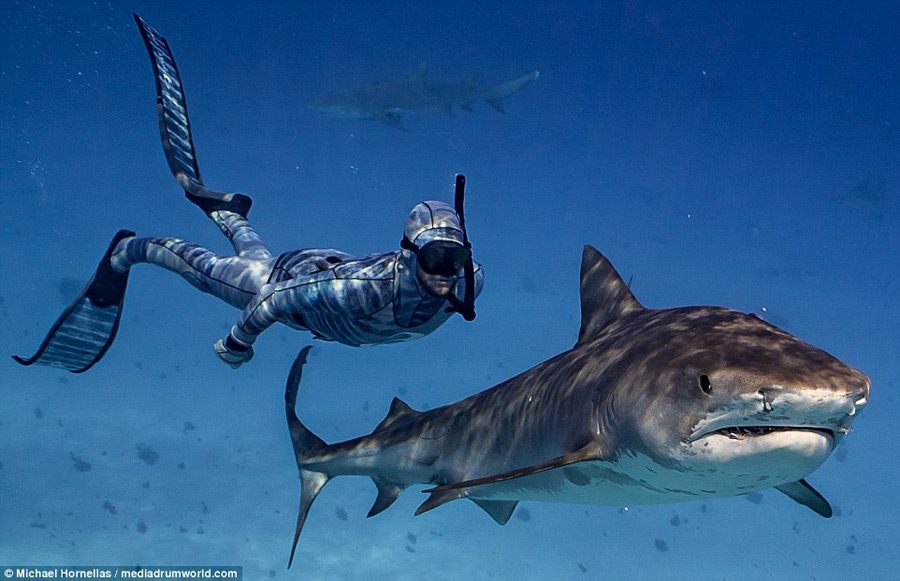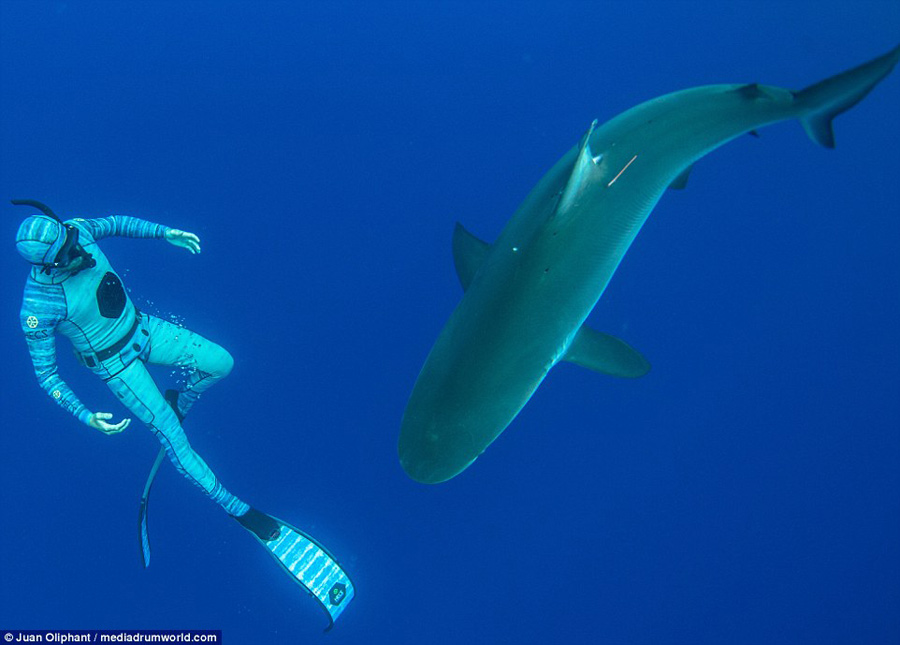

When swimming in the open ocean, your every movement gives off invisible signals to the fish and sea creatures around you to betray your presence.
Sharks, lobsters, crayfish, rays, eels, lampreys, ratfish, lungfish, sturgeons and some dolphins all have the ability to detect these tiny electrical impulses given off by the movement of muscles and the beat of your heart.
But a new wetsuit could allow divers to slip undetected through the water by preventing these signals from being given off, acting like a kind of underwater 'invisibility cloak'. It promises to let divers to get close to large predators like sharks that often use this 'sixth sense' to detect prey.

When you are swimming in the ocean, your body gives off invisible signals warning marine creatures of your presence. Sharks, lobsters, crayfish, rays, eels, lampreys, ratfish, lungfish, sturgeons and some dolphins can all detect the electrical impulse given off with each beat of your heart.
The wetsuit was tested by marine biologist Ricky Elliott during a research trip in Hawaii, who was featuring in a series of stunning photographs showing him up close with a variety of animals.
'I was testing a cutting edge wetsuit technology…comprised of a Faraday cage weaved into the wetsuit fabric to block the bodies electrical signal, enabling researchers, photo/videographers, spearos and divers, closer and more natural encounters with animals' Mr Elliott said.
Animals in the sea can detect muscle movement, heartbeat and brain activity through electroreception.
The beating of a heart or contracting of a muscle sends a spontaneous electrical signal.
But this new wetsuit blocks the electrical signals, meaning people can get closer to animals without scaring them away.
The 'Stealth wetsuit' was invented by HECS Aquatic, a concealment technology company based in New Zealand.

But a new wetsuit (pictured) prevents these signals and works as a kind of 'invisibility cloak' for the sea, allowing divers to get closer to the animals of the deep.

The 'Stealth wetsuit' was invented by HECS Aquatic, a concealment technology company based in New Zealand. It blocks the electrical signals, meaning people can get closer to animals without scaring them away.

Marine biologist Riley Elliott testing the suit out with a tiger shark, pictured. The wetsuit principle is based on a Faraday cage, invented by the scientist Michael Faraday in 1836. Faraday discovered that inside a sphere of conducting material, the electric field balances out to become zero, even in an external electrical field.

HECS Aquatic built a conductive grid that attenuates electrical fields into their wetsuit. 'HECS is made with a conductive carbon fibre mesh designed to reduce your electrical energy field,' the company website says.
The technology 'blocks 95 per cent of the electrical signals given off by your muscle movement,' Ricky Elliott said in a YouTube video explaining how it works.
It works using the same principle that means you will never be struck by lightning while inside your car.
The principle is based on a Faraday cage, invented by the scientist Michael Faraday in 1836.
Faraday discovered that inside a sphere of conducting material, the electric field balances out to become zero, even in an external electrical field.
This is because external electrical field causes the electric charges within the cage's conducting material to be distributed such that they cancel the field's effect in the cage's interior.
HECS Aquatic built a conductive grid that attenuates electrical fields into their wetsuit.
'HECS is made with a conductive carbon fibre mesh designed to reduce your electrical energy field,' the company website says.
Mr Elliott is not the only one to enjoy the proximity of creatures of the deep after donning the wetsuit.
'I've noticed a marked difference in how close I can approach certain marine life underwater while wearing the HECS suit – a worthwhile advantage for any cameraman,' said Dave Abbot, a filmmaker in New Zealand.
'[The] first time diving in my HECS suit I got all three cray species in the one dive. I never thought it would be possible or this easy,' said Jordan Murley, a marine biologist.
'The crays were slow or non responsive to touch and movement when I was wearing the HECS suit.'
'During a recent trip to the Bahamas I had the opportunity to wear the HECS dive skin,' said Jason Scanlon, a diving instructor.
'During the first set of dives I started to notice that most of the wild life ignored me and would swim around and near me as if I wasn’t even there.
'I was able to get very close to the life, which allowed me to capture photos and video that others on the dive could not. As the week progressed I noticed that most of the life would treat me as if I were one of them instead of an intruder into their space, some even ran into me.'
The wetsuit is available starting from $399 (£300) in Europe, Australia and New Zealand and $449 (£338) in the US, Canada and Mexico.

Mr Elliott pictured in the wetsuite with a sandbar and galapago sharks. The sandbar shark is also called the thickskin shark or brown shark. It is one of the biggest coastal sharks in the world. Galapagos sharks are active predators often encountered in large groups.

The technology 'blocks 95 per cent of the electrical signals given off by your muscle movement,' Ricky Elliott said in a YouTube video (above) explaining how it works. Shown in picture swimming alongside a poisonous stingray.

Mr Elliott is not the only one to enjoy the proximity of creatures of the deep after donning the wetsuit. 'I've noticed a marked difference in how close I can approach certain marine life underwater while wearing the HECS suit – a worthwhile advantage for any cameraman,' said Dave Abbot, a filmmaker in New Zealand.
Day|Week

 Thai most beautiful transgender Nong Poy release new photos
Thai most beautiful transgender Nong Poy release new photos Top 10 livable Chinese cities
Top 10 livable Chinese cities The last primitive tribe in China
The last primitive tribe in China China's first intelligent security robot debuts in Chongqing
China's first intelligent security robot debuts in Chongqing A Total of 3,552 Subscribers Vanish In Two Days; YouTube Closes All Doors to Users’ Inquiries
A Total of 3,552 Subscribers Vanish In Two Days; YouTube Closes All Doors to Users’ Inquiries Out of this world! Futuristic UFO-shaped yacht has its own garden and a stunning underwater viewing deck
Out of this world! Futuristic UFO-shaped yacht has its own garden and a stunning underwater viewing deck An old tea house in Chengdu
An old tea house in Chengdu Furious Customer Crushes All the Buns from Vendor Just Because He Was Given the Wrong Flavor
Furious Customer Crushes All the Buns from Vendor Just Because He Was Given the Wrong Flavor 20 post-90s couples hold ’naked marriage‘ in E. China
20 post-90s couples hold ’naked marriage‘ in E. China Female official wearing traditional Han costume to promote local tourism
Female official wearing traditional Han costume to promote local tourism